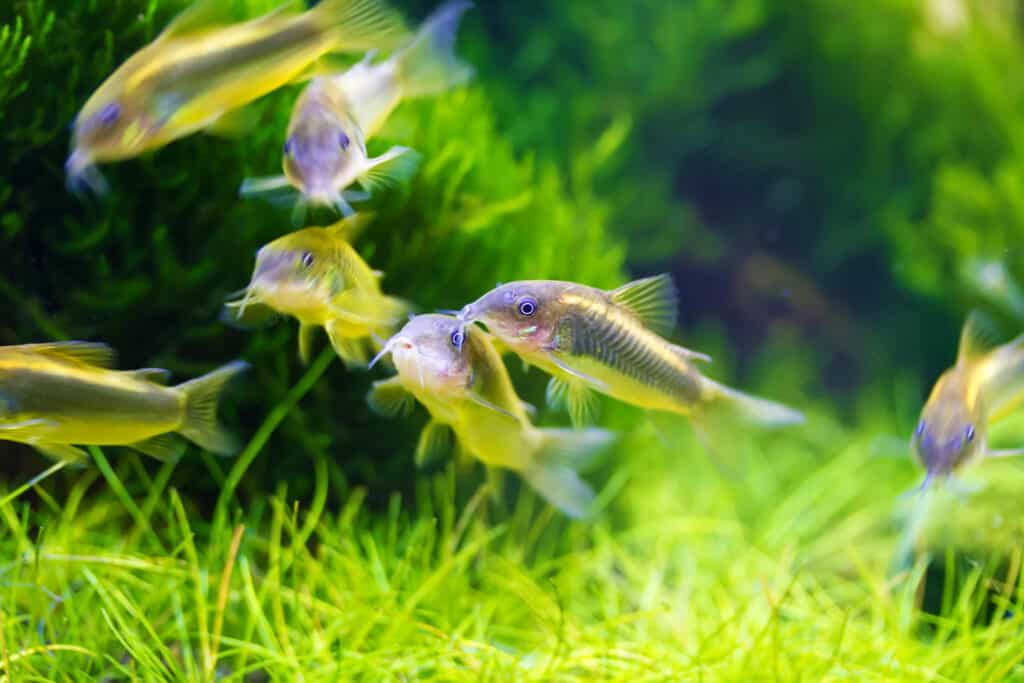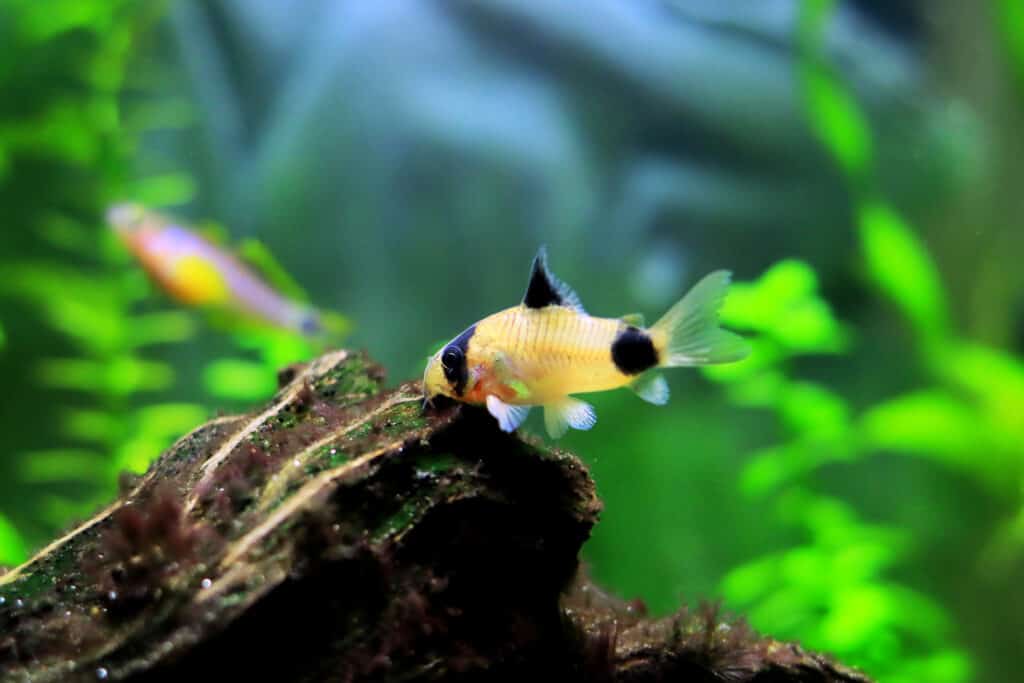
Corydoras and Otocinclus are two of the most popular fish options for those in the fish-keeping hobby who are looking for bottom-dwellers to add to their tank.
These two share some similarities, however, some key differences separate these two species that may help in determining which one is right for you and your tank.
Both Corydoras and Otocinclus are peaceful, bottom-dwelling fish that prefer to be kept together in groups of the same species. They also enjoy similar tank parameters and setups. But do differ in size, physical appearance, and dietary preferences.
Let’s dive deeper into the similarities and differences between Corydoras and Otocinclus to help understand which fish would be right for you.

Similarities Between Corydoras and Otocinclus
Let’s jump into the similarities between Corydoras and Otocinclus. Looking at where they match up in preferences and nature.
Preferred Water Parameters
Coming from the same region in the world, their preferred water parameters are very similar.
Both enjoy temperatures in the 70’s range, allowing for a slight bump up to the low 80’s.
Otocinclus are more affected by water changes and have a slightly tighter restriction on parameters like pH, but both will be comfortable in pHs ranging from 7 to 7.5.
Otto’s can go a little more acidic down to 6.8, and Corydoras can go with water that is a little more alkaline, being able to go up to 8.0.
Social Behavior and Community
Both Otocinclus and Corydoras are shoaling fish, meaning they prefer to be kept in groups.
The more of each, the better without overstocking the tank, but generally keeping anywhere from 4-6 of the same variants is a good starting point to keep both species happy.
They are also both peaceful fish that will be found generally at the bottom of the tank.
This makes both great additions to any community fish tank.
Tank Setups
Both enjoy planted tanks that can provide them with many hiding spots.
Both can survive in tanks with either sandy or gravel substrates, corydoras do have a slight preference for soft, sandy substrates to help them in looking for food as they dig into the ground, but they can survive and live with gravel.
From their preference to be kept in semi-large groups of 4 or more, it is also generally recommended for both that they be kept in a minimum tank size of 20 gallons.

Differences Between Corydoras and Otocinclus
Though there are similarities between these two, there are distinct differences in their appearance, dietary preferences, and the way they act in a tank that should be considered when trying to decide between the two.
Physical Appearance
With roughly 160 variants of corydoras, there is a vast amount of characteristics from patterns and colors to choose from in the diverse species.
From the popular bronze corydoras with its brownish-green colorations to the panda cory with its beige body and distinct black markings on its face, dorsal, and before its tail.
Patterned corydoras include the ever-favorite sterbai corydoras, with its unique stripes of polka-dots and orange fins, to the julii corydoras with its special markings across its body, there is something that will catch the eye of every aquarist.
These physical variations also go into the size of corydoras as throughout the variants their adult size can range from 1-4 inches.
This range gives options both for small and large tanks, and the size of fish needed for their tank.
Otocinclus on the other hand are much less diverse in their physical appearance. Having about 20 variants, most will have a similar look with a black stripe going down the length of their bodies.
Some variations are visible in the areas above and below this line.
Their range of adult size is also much closer between the variants, as they will generally not exceed 2 inches.
Dietary Preferences
Both Ottos and Corys can eat similar food, and a varied diet will help both in thriving and keeping healthy, however, there are some differences in what their staple food choices are, and how they feed.
Otocinclus can be considered herbivores, mostly adhering to a fully plant-based diet.
The main choice of food for their diet is algae, and they would do well in tanks that can provide them with a constant supply.
They will be found up against the tank glass feeding on the algae in the tank, as well as on plants and other decorations doing the same thing.
That is why if a tank needs some algae control, these bottom dwellers may be the answer.
This preference for algae though does affect how difficult their care is viewed in the hobby.
They are considered harder to care for compared to Corydoras, however in many cases these issues will stem from not getting enough food to eat, especially if the algae supply is limited in the tank.
Corydoras on the other hand are omnivores that will eat both plant and meat-based foods.
They will be found scavenging for food, sifting through the substrate looking for any leftover food they can eat.
They are not known for eating much algae, possibly eating it on occasion but it is not a main staple food in their diet.
If you are looking for an algae control fish, this is probably not the best choice for you.
Activity Levels
As noted above, both Corydoras and Otocinclus are peaceful community fish, however they do normally have different personalities in a tank.
Corydoras are normally more active, and energetic, roaming the tank together and scavenging for food.
This will give the bottom of your tank more life and movement.
Otos on the other hand are typically for calm, and a little more shy, which could be perfect for some tanks, but won’t provide the same movement if that is what you’re looking for.

Overview of Corydoras
After looking at these two species’ similarities and differences, let’s take a look at Corydoras as a species itself.
Corydoras are originally from South America and include a diverse group of armored catfish.
They are well known for their playful, energetic behavior in tanks and their distinctive armored plates.
They come in a large variety of colors, patterns, and sizes to the point where anyone should be able to find one that would be perfect for their tank.

Overview of Otocinclus
Otocinclus are a small and peaceful fish that also originates from South America.
Unlike Corydoras, Otocinclus also known as Otos, have a slender body and will commonly be seen up against the glass and decorations of the aquarium.
They are excellent algae eaters, and it is a main staple of their diet making them perfect for tanks that could use some help in the algae control department.
Final Thoughts
Both Otocinclus and Corydoras can make an excellent addition to your community tank, which can help add some life and movement to the bottom of your tank.
They can both go in similar tanks because of their similarities in tank parameter needs and setups.
Where they mostly differ is in their appearance and food preferences, making the choice very much more of what look you are going for in your tank, and food availability you have that can help determine which species might be best for you.
Corydoras are generally more energetic and playful, whereas Otos are excellent algae eaters.
Understanding the similarities and differences between Otos and Corydoras can help ensure a thriving aquarium environment, by knowing which species will help bring the needed characteristics to your tank.
